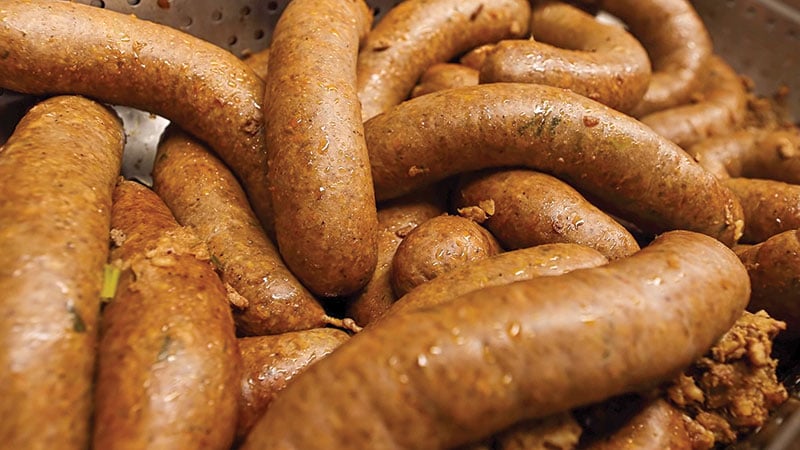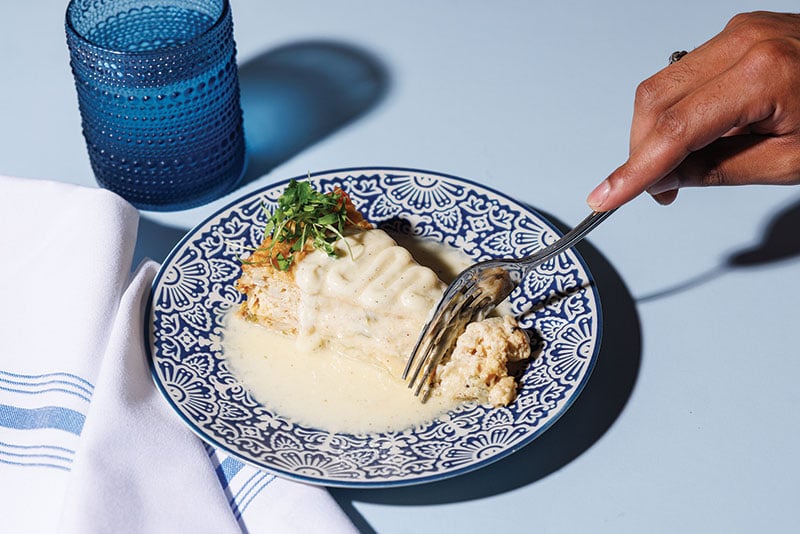Tracing the Roots of Boudin from Europe to the Cajun Prairie

It’s been said that “Happiness is a hot piece of boudin.” In South Louisiana, roadside stops and meat markets are distinguished by their boudin — whose is hottest, whose casing is tougher, whose rice and meat mixture has the best texture.
According to the state’s famed Chef John Folse, the Germans who came to Louisiana in 1725 are responsible for teaching the Cajuns how to make sausage. Boudin derived from this sausage-making process, with the addition of rice and vegetables, like onions and bell pepper, to the meat filling. The Germans also introduced the Cajuns to all forms of charcuterie and the boucherie (community butchering usually with pigs), which resulted in smoked meats like andouille, chaudin, tasso and chaurice.
Boudin also has roots in France, where boudin noir (black boudin) and boudin blanc (white boudin) were popular in the 1300s. Boudin historian Robert Carriker notes in his book “Boudin” that the earliest recorded mention of the stuffed sausage in Louisiana dates to May 9, 1805. “The journals of Lewis and Clark recount how their French fur trapper, Toussaint Charbonneau, fashioned a buffalo intestine into a casing, filled it with meat and kidney suet, baptized it in the Missouri River with ‘two dips and a flirt,’ then boiled and fried it in bear grease. This innovative creation was dubbed “boudin” and celebrated as a “forest delicacy,” he writes.
Before 1930, the only way to get a link of boudin would have been to attend a boucherie. Small-town grocery stores like Johnson’s in Eunice started selling it as a Saturday tradition during the 1940s, and more followed suit. Today, there are more boudin shops in Acadiana than you could taste in a day.
Looking back to that Saturday tradition, locals around Acadiana often start their morning with a link of boudin, which has led to early-morning “boudin tours” for those who are serious about their links. Lafayette Travel’s Cajun Boudin Trail recommends trying “one boudin after another, link after steaming hot link, to form a chain that connects, or literally links, the Cajun prairie towns to the Creole bayou communities.”
Boudin is best understood through taste. Each link is different and unique, because each community has their own recipe. At The Best Stop in Scott — designated the Boudin Capital of the World in 2012 — you’ll find pork, spice and a touch of liver in the recipe, not to mention smoked boudin and chaudin, described as “Cajun pork haggis.” At Earl’s in Lafayette, the boudin is thick with green onions and more rice than pork. Johnson’s Boucaniére may have moved from Eunice to Lafayette, but its hot boudin recipe remains the same, relying on a good dose of black pepper. In Duson, the links at Menard’s are “dark, piquant, and meaty, with a notable green onion crunch,” according to Lafayette Travel.
Each link of boudin is its own culinary journey. There are even those stuffed with crawfish, shrimp and cauliflower (in place of rice) now. Like most Cajun foods, boudin has evolved with the times to fit our current palate, but there’s still nothing like a hot link on a Saturday morning.
Rice, Spice & Everything Nice
Celebrate boudin in print, in person and on your plate.
BOOK
“Boudin: A Guide to Louisiana’s Extraordinary Link” by Robert Carriker
ulpress.org
EVENT
The Scott Boudin Festival
April 10-12
scottboudinfestival.com
RECIPE
Boudin King Cake by George Graham
acadianatable.com


